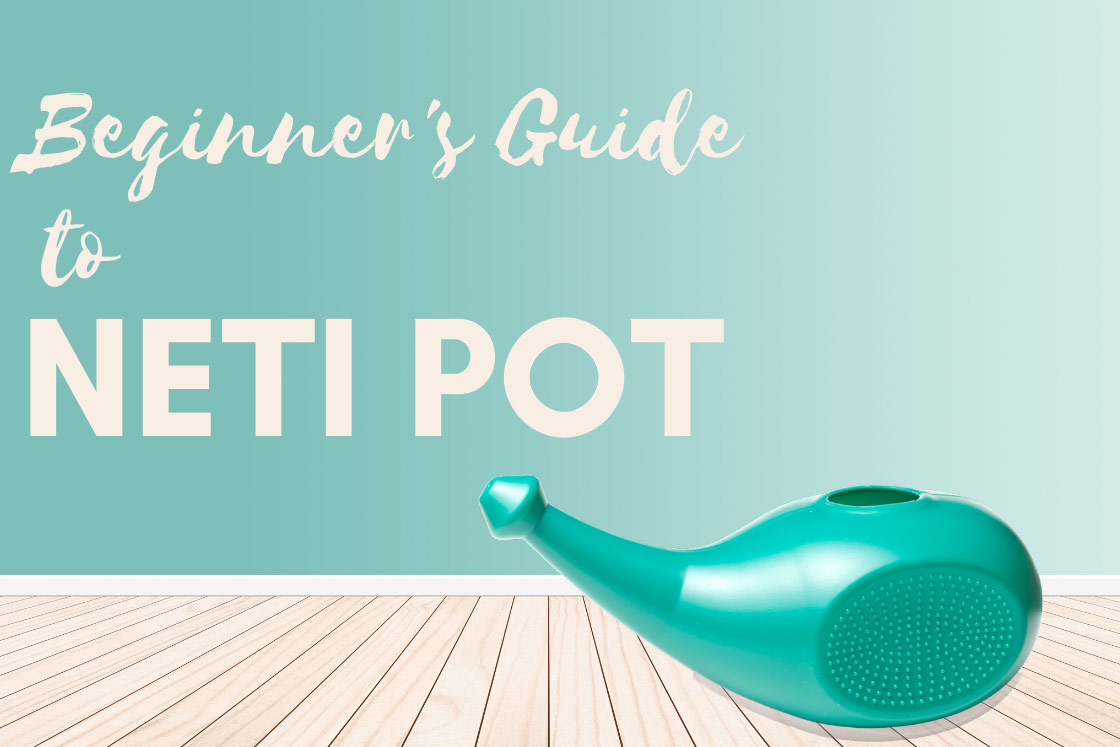
If you have gone through nasal congestion, you know how discomfort it feels in breathing during it. The main cause behind the clogged nose is inflammation in nose blood vessels that triggered by cold, flu, allergies & sinus infection. Read on this article for How to use Neti Pot correctly.
After reading this informative article, you can perform Neti for nasal irrigation to flush out the excess mucus and debris from the nose & sinuses. Although this technique of nasal irrigation in Yoga was practiced as a part of Shatakarma (6 purification techniques) since ancient times.
What Is a Neti Pot?
A Neti Pot is a teapot shape device in which we fill lukewarm saline solution. It has two round openings, upper larger one to let the fluid in and a spout through which the fluid exits.
The spout end of a Neti Pot is placed at one nostril & under the action of gravity, the saline solution lets out from another nostril automatically. Typically it has a handle to lift. This resembles Ginni’s lamp in appearance.
A Neti Pot has been used as a nasal irrigation device. People have been using it since a along time. Neti Pot helps in cleansing of the nasal passage and the sinus cavities. This restores non-obstructive breathing.
Different Types of Neti Pot
Based on the material of pot, Neti Pot has different types.
1. Plastic Neti Pots
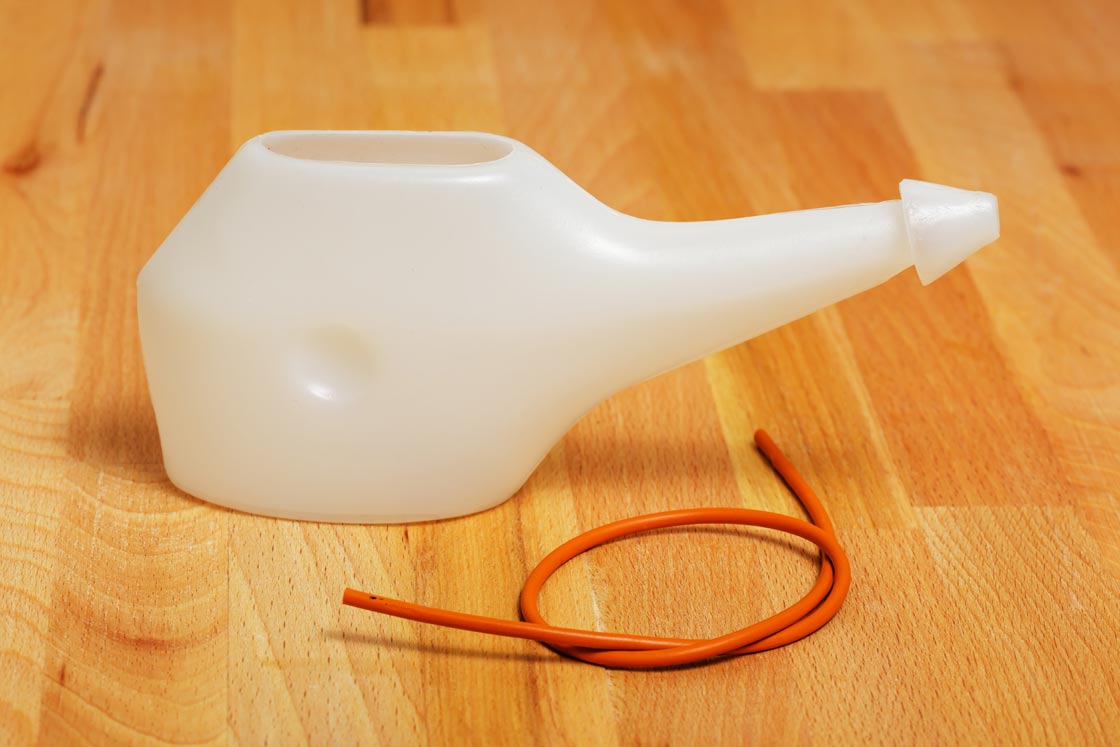
Due to lightweight, the plastic Neti Pot does not stress the hand while pouring the fluid through the nostril. Also, they are easy to carry from one place to another.
Who can use the plastic Neti Pot?
- Those who are habitual of using light objects.
- People with traveling schedules.
Problems with Plastic Neti Pot
- Some manufacturers are using Grade 3 (PVC) plastics in the production of plastic Neti Pots. Grade 3 (PVC) plastic can cause cancer [efn_note] Common Carcinogens You Should Know https://www.webmd.com/cancer/know-common-carcinogens [/efn_note] in humans.
- In plastic material, it becomes tough to feel the exact temperature of the water that is within Neti Pot.
- Lastly, plastic material is not a good choice for the long run because it emits an unpleasant odor with age.
2. Ceramic Neti Pots
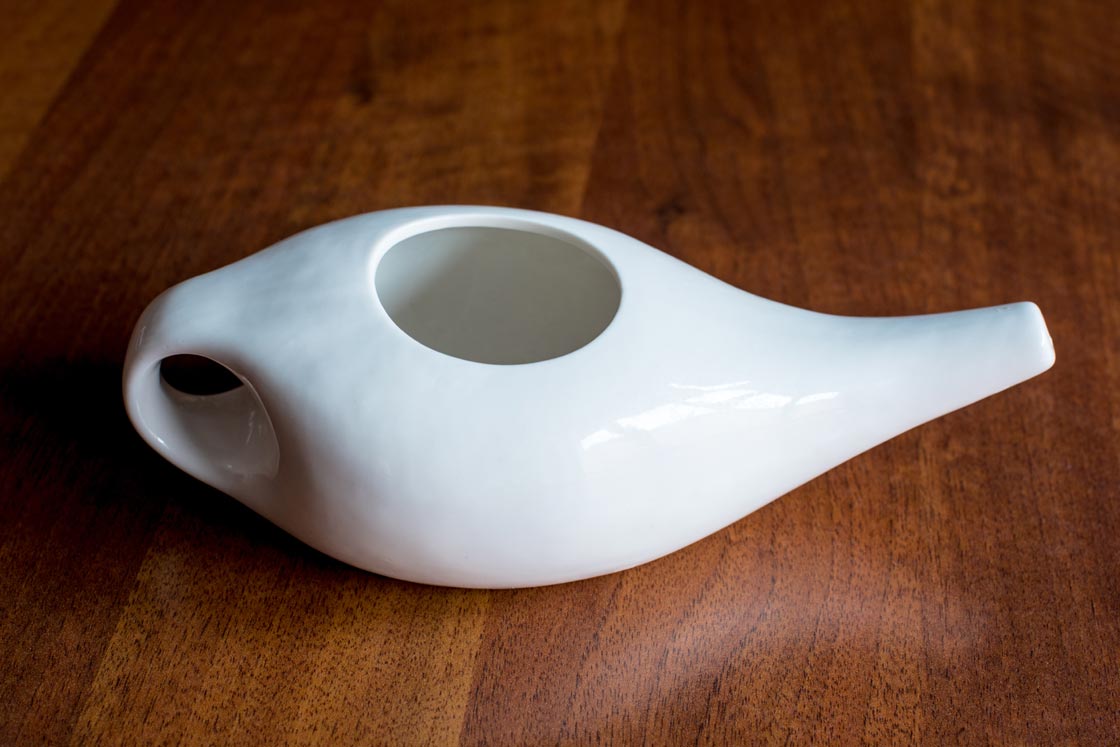
Ceramic Neti Pots are inorganic solids and are lustrous in appearance. They are durable and heat resistant, which maintains the lukewarmness of the fluid. However, it ultimately helps in the maintenance of body homeostasis (constant body temperature).
Who can use the ceramic Neti Pot?
- Individuals with disturbed homeostasis.
- Those who are fond of ceramic objects.
Problems with Ceramic Neti Pot
- One of the obvious reasons why people do not prefer using ceramic Neti Pots because ceramic material is fragile in nature. It can break easily due to improper handling.
- A beginner can feel issues in plugging spout end of ceramic Neti Pots in nostrils because of a lack of proper cone tip.
3. Copper Neti Pots
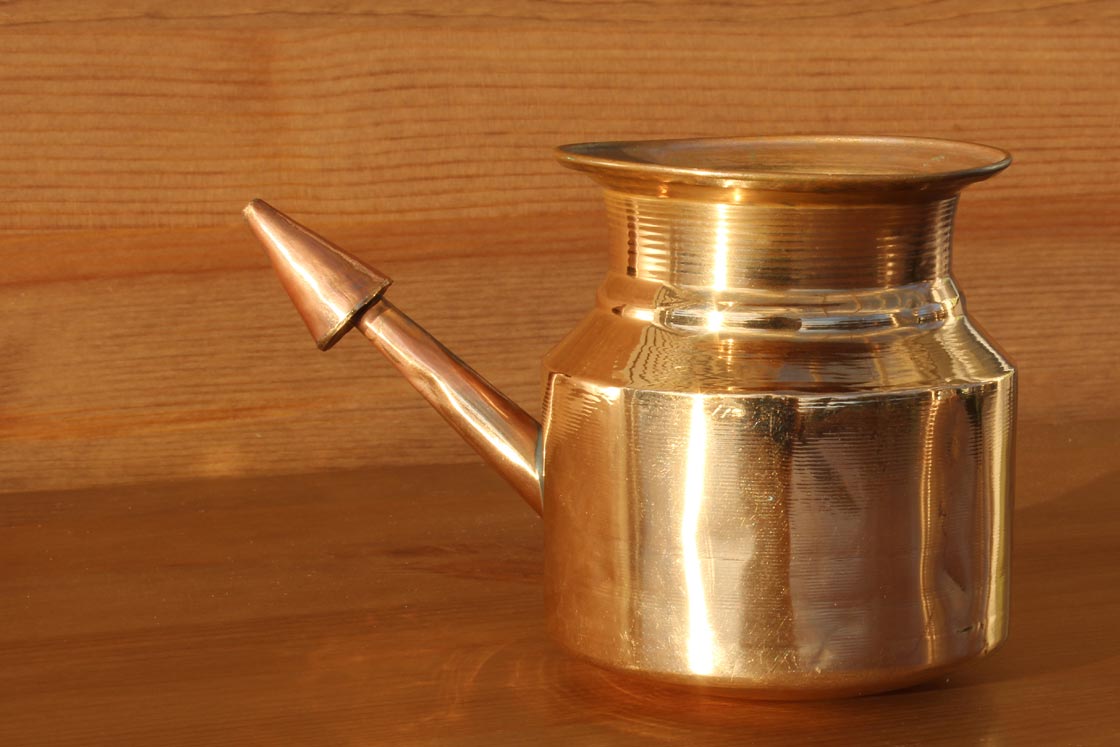
According to Ayurveda, keeping fluid in the copper vessel is beneficial. The copper Neti Pot has antibacterial properties that sterilize the fluids. It also maintains the pH of nasal passage and sinuses. Therefore, using a copper Neti Pot is of paramount benefit.
Who can use the copper Neti Pot?
- Patient with imbalanced pH.
- People prone to minor infections.
- Those who are allergic.
Problems with Copper Neti Pot
However, copper Neti Pot is a great choice one can, still, it has the following demerits:
- Copper Neti pots are quite expensive as compare to other types.
- Copper material gets tarnished when it comes in contact with the air [efn_note] What Causes Copper to Tarnish? https://sciencing.com/causes-copper-tarnish-13011.html [/efn_note]. So after use of a few times, it demands proper rinsing.
Benefits of Neti Pot
Neti Pot is a great tool if you want to get rid of that stuffy nose. Also, nasal irrigation has great benefits for health, some of them are the following:
1. Relieves Rhinosinusitis
Rhinosinusitis is the condition of inflamed sinus cavities, which is caused by the infection of the pathogens. The condition followed by the pain in the facial, nasal and forehead area.
Nasal irrigation helps in clearing the dust, pathogens and excess mucus from the blocked sinuses, which ultimately relieve its symptoms.
2. Clears Nasal Cavities
Alternatively pouring of the saline solution through each of the nostrils clears the hardened mucous layer. It also removes suspended dust over the nasal hairs and pollutants across the nasal passage. This clears the nasal pathway.
3. Improves Oxygen Intake
Unwanted foreign objects and cough decreases the quantity of air volume per inhalation, which affects oxygen transportation. Nasal irrigation with the Neti Pot helps in the eradication of all the obstruction causing agent in the nasal discharge.
4. Safe During Pregnancy
Mayo clinic [efn_note] Is it safe to take Claritin or other allergy medications during pregnancy? https://www.mayoclinic.org/ [/efn_note] recommended the use of a neti pot during pregnancy as an alternative to reduce the use of allergy medications. This practice relieves nasal and eye symptoms of seasonal or perennial allergic rhinitis.
5. Relieves Snoring
The snoring cause of congested nose [efn_note] Chronic Nasal Congestion at Night Is a Risk Factor for Snoring https://jamanetwork.com/ [/efn_note] is a common problem in people. Nasal irrigation relieves the symptoms of snoring by opening nasal cavities.
6. Sharpens The Vision
When taking special reference to Jala Neti, it can improve one’s vision. A review study [efn_note] therapeutic effects of Neti Kriya https://www.sciencedirect.com/science/article/pii/S0975947617306216 [/efn_note] on the therapeutic effects of Neti Kriya has proved nasal irrigation is helpful in vision improving, eye pain, eye strain, watering, and heaviness of eye.
Nasal Irrigation Using Neti Pot – Ingredients
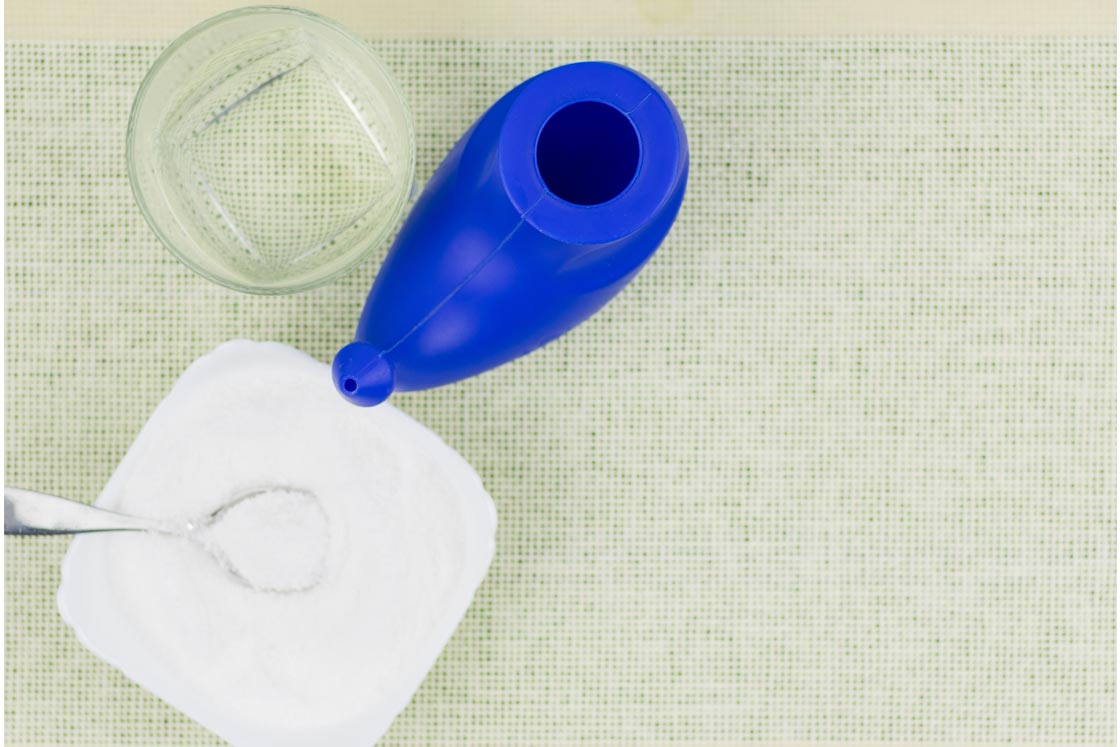
To use a Neti Pot for nasal irrigation, firstly we need to prepare a solution for it. A Neti Pot solution is a combination of 2 to 3 ingredients, which makes a solution suitable for use.
However, all three Ingredients has its own function & effects. They are as follows:
1. Salt: A Friend of the Mucous Membrane
Saline solution has a similar salt concentration as other body fluids such as tears. It helps in soothing the mucous membrane of the nasal passage.
Using good quality salt that especially occupies in ‘neti salt’ or ‘non-iodized salts’ is helpful. However, It does not irritate the mucous lining, which is a common symptom in the case of the table or another impure salt source.
2. Baking Soda: Moisturizing Agent
Frequent use of saline irrigation could irritate the mucous lining of the nose. It also disturbs the natural environment of the nasal passage and sinuses.
Therefore, adding baking soda to the saline solution helps in restoring the moisture of the nasal lining. It also helps in moistening the thick hardened mucous membrane.
3. Water
Water is the basic ingredient of the solution. There is the certainty of getting infected by considering an unhygienic water source. So, selecting pure water is a preventive measure against infection.
To ensure water quality for nasal rinsing, CDC suggested [efn_note] Treating Water Used for Nasal Rinsing
https://www.cdc.gov/ [/efn_note]:
- Boil water for 3 to 5 minutes (longer at higher altitudes) then left it cool
- Use water from stores which contain label of distilled or sterile water
- If boiled or sterile water is not available, use a filter that designed to remove common germs
- If all the above ways are not available, CDC has mentioned a way to disinfect water to make it is safe from Naegleria (brain-eating amoeba).
Making Neti Solution for Nasal Irrigation
The very first thing before we rinse nasal cavities using a Neti Pot is a saline solution. To make your own neti solution at home, follow these steps:
- Take a vessel, water, non-iodized salt and baking soda near you before preparing the solution.
- Add 250 ml sterilized or distilled water into the vessel (tap water is only considered after well boiling).
- Add 1/2 spoon of non-iodized salt and 1/2 spoon baking of soda followed by the mixing of the solution.
- Stir the solution well in the vessel so it attains the homogeneity.
And, this is our saline solution ready to use.
Easy Steps to Use Neti Pot

Once you have prepared a saline solution after following the above steps, now come over to your sink & follow these steps given below.
Step 1: Handling Over the Sink
- Take dry & clean Neti Pot in hand and pour the saline solution from the vessel into it.
- Now proceed to the sink and bend over on it.
- Slightly tilt your head at the 45-degree angle to one side (Left or right, you can start from either side.).
- Tuck your chin to prevent water from reaching your mouth & throat.
- Your forehead and chin should be in a straight line.
Step-2 Pouring Water & Breathing Through Mouth
- Lift the Neti Pot and insert its spout into the nostril that is at upper end (say right side nostril).
- Pour the saline solution into the nostril by increasing the inclination of the Neti Pot. Simply bend your hand from elbow to increase inclination.
- Breathing must be performed by the mouth while the solution flows through the nostrils.
- Keep the spout of the Neti Pot attached to the nostrils until it gets empty.
Once done with one side, repeat the similar procedure with the other nostril as well respectively.
Step-3 Mucous & Solution Discharge
- Once you have completed the process from both the nostrils, slowly remove the Neti Pot.
- Drain out all the solution and mucous remained in the nose and throat.
- Straight up the head and stand tall. clean the nose & mouth with tissue paper.
- Clear the nasal passage by inhaling and exhaling few breaths.
Avoid These Common Mistakes
- Don’t insert the spout of the Neti Pot too deep. This could harm the septum of the nose.
- Focused breathing through the mouth is advisable to prevent the chocked neck.
- Don’t over inclined your elbow while pouring water into a nostril, otherwise Neti Pot solution can run onto your face.
- Perform all the steps slowly & gently otherwise cause of nervousness, neti solution can run out to the throat. Don’t worry about this, as there is no harm if a little solution goes in the throat.
Points to Check
- Avoid any blockages in the Neti Pot before pouring the solution into it.
- Make sure water is sterilized or boiled tap water for the Neti Pot.
- The saline solution should be lukewarm neither too cold nor too hot.
- Clean the Neti Pot with the anti-bacterial soap after the use & keep it dry.
Don’t Use Neti Pot When
1. Nosebleeds (Epistaxis) or Nasal Irritation
Due to the bunch of capillaries in the nose area, it is susceptible to suffer the nosebleeds [efn_note] Nosebleed (Epistaxis) https://my.clevelandclinic.org/health/diseases/13464-nosebleed-epistaxis [/efn_note].
However, such conditions drastically increase the chances of rupturing capillaries. The use of Neti Pot irrigation could worsen the condition of the patient. So, avoid nasal irrigation in nosebleeds.
2. Headache
Headache does not have to possess a particular reason to occur. Nasal irrigation during headache could result in losing the concentration required to breathe through the mouth, which could lead to the choked neck.
3. Cough & Cold
Frequent sneezing when suffering from the cold could be fatal if nasal irrigation is practiced. This could lead the saline solution to enter the windpipe, which could stop breathing for some period of time. Therefore, it is advisable to avoid it in that condition.





Hi pls, advise Mudra for congestion with mucus in the throat. Throat clearing constantly sometimes hard to clear. Thank you
Hello, neti solution in itself is a good remedy for throat congestion. In addition to it, you can do Linga mudra, Varun Mudra, and Brahma Mudra for clearing mucus in throat.
Thank you, Ashish. Can all these Mudras done On the same day?
Thank you.
Yes, these 3 mudras you should do in one sitting.